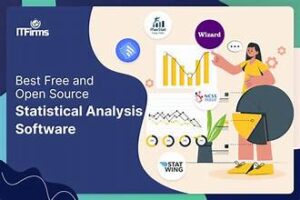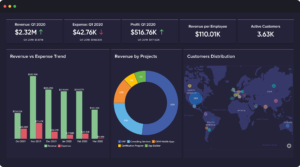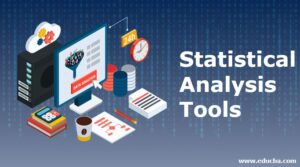
In the rapidly evolving world of data analysis, selecting the right statistical software is crucial for obtaining accurate results and making informed decisions. As we move into 2024, the landscape of statistical software is more dynamic than ever, with new tools and updates enhancing data analysis capabilities. This comprehensive guide will explore the top statistical software options available in 2024, offering a detailed comparison to help you choose the best tool for your needs.
1. RStudio
Overview: RStudio is a powerful open-source integrated development environment (IDE) for R, one of the most popular programming languages for statistical analysis. It provides a user-friendly interface for data manipulation, statistical modeling, and visualization.
Key Features:
- Comprehensive Packages: Access to numerous R packages for various statistical methods and data visualization.
- Interactive Plots: Tools for creating interactive and customizable plots.
- Reproducible Research: Integration with R Markdown for creating dynamic documents.
Pros:
- Extensive community support and resources.
- Highly customizable with plugins and extensions.
- Strong support for reproducible research practices.
Cons:
- Steeper learning curve for beginners unfamiliar with R programming.
- May require additional setup for certain advanced features.
2. SPSS Statistics
Overview: IBM SPSS Statistics is a long-established tool known for its robust statistical capabilities and ease of use. It is widely used in social sciences, market research, and academia.
Key Features:
- User-Friendly Interface: Intuitive point-and-click interface suitable for users of all skill levels.
- Advanced Statistical Procedures: Includes procedures for complex statistical analyses like factor analysis and structural equation modeling.
- Integration with Other IBM Tools: Seamless integration with other IBM analytics and data management tools.
Pros:
- Easy to learn and use with minimal coding required.
- Extensive documentation and support from IBM.
- Strong in handling large datasets and performing complex statistical tests.
Cons:
- Higher cost compared to open-source alternatives.
- Limited flexibility for custom analyses and scripting.
3. SAS (Statistical Analysis System)
Overview: SAS is a comprehensive software suite for advanced analytics, business intelligence, and data management. It is known for its robust statistical analysis and data manipulation capabilities.
Key Features:
- Advanced Analytics: Includes features for predictive modeling, data mining, and statistical analysis.
- High Performance: Designed to handle large volumes of data efficiently.
- Strong Security Features: Robust security measures for sensitive data.
Pros:
- Highly reliable and scalable for enterprise-level applications.
- Extensive library of statistical procedures and data analysis tools.
- Strong customer support and training resources.
Cons:
- Expensive licensing and maintenance costs.
- Requires specialized training to use advanced features effectively.
4. MATLAB
Overview: MATLAB is a high-level language and interactive environment for numerical computation, visualization, and programming. It is widely used in engineering, scientific research, and financial modeling.
Key Features:
- Powerful Numerical Analysis: Advanced tools for numerical computation, linear algebra, and optimization.
- Flexible Programming Environment: Customizable scripts and functions for tailored analyses.
- Integration with Hardware and Simulink: Strong support for simulation and hardware integration.
Pros:
- Excellent for complex mathematical modeling and simulations.
- Large library of built-in functions and toolboxes.
- Strong support for graphical visualization and data representation.
Cons:
- High cost of licensing and toolboxes.
- May be overkill for simpler statistical tasks.
5. Stata
Overview: Stata is a versatile statistical software package that combines a user-friendly interface with powerful data management and statistical analysis tools. It is favored in fields such as economics, sociology, and political science.
Key Features:
- Comprehensive Data Management: Tools for cleaning, organizing, and managing large datasets.
- Extensive Statistical Procedures: Includes support for a wide range of statistical techniques and models.
- Interactive Graphics: Capabilities for creating high-quality charts and graphs.
Pros:
- User-friendly with a balance between ease of use and advanced features.
- Excellent for panel data and time-series analysis.
- Regular updates and active user community.
Cons:
- Licensing can be expensive, especially for academic users.
- Less flexibility compared to open-source tools like R.
6. Python with SciPy and StatsModels
Overview: Python, with libraries such as SciPy and StatsModels, provides a powerful and flexible environment for statistical analysis. Python’s popularity has surged due to its versatility and the extensive ecosystem of libraries.
Key Features:
- Versatile Libraries: SciPy and StatsModels offer a wide range of statistical functions and models.
- Integration with Data Science Tools: Seamless integration with other data science libraries like Pandas and NumPy.
- Customizable Analysis: High flexibility for developing custom statistical models and analyses.
Pros:
- Free and open-source, with extensive community support.
- Highly versatile and adaptable to various data analysis tasks.
- Integration with machine learning libraries and big data tools.
Cons:
- Requires programming knowledge and familiarity with Python.
- May involve more setup and coding compared to GUI-based tools.
7. JMP
Overview: JMP, developed by SAS, is a data analysis tool designed for visual and interactive statistical analysis. It is popular in the fields of engineering, quality control, and research.
Key Features:
- Interactive Visualization: Powerful tools for creating dynamic visualizations and exploring data interactively.
- Advanced Modeling: Supports a range of advanced statistical models and analyses.
- User-Friendly Interface: Intuitive interface with drag-and-drop functionality.
Pros:
- Excellent for exploratory data analysis and visualization.
- Strong emphasis on interactive and visual data exploration.
- Good balance between ease of use and advanced features.
Cons:
- Licensing costs can be high.
- Limited scripting capabilities compared to programming-based tools.
Conclusion
Selecting the right statistical software for 2024 depends on your specific needs, budget, and level of expertise. RStudio and Python with SciPy and StatsModels offer powerful open-source solutions for those comfortable with coding, while SPSS Statistics, SAS, and Stata provide robust options for users seeking more user-friendly or enterprise-level features. MATLAB and JMP offer unique strengths in numerical analysis and interactive visualization, respectively.


